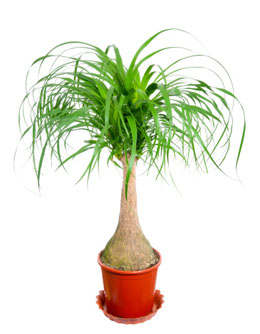The ponytail plant derived its name from its cascading leaves. Go through the article to know more about this popular houseplant.

The ponytail plant is very popular as a houseplant, and is known in many other names, like ponytail palm, bottle palm, bottle tree, elephant's foot tree, etc. The name ponytail plant is derived from its leaves, that cascade from the top. Even though it has a tall and tapering trunk, with leaves emerging from the top; it is not a true palm, but belongs to the genus
Beaucarnea in the family
Ruscaceae. This plant is native to some parts of Mexico. The ponytail plant can be kept both indoors and outdoors. They require less maintenance and are easy to care for.
Features
This plant resembles a palm tree in appearance, but is not a real palm. Its popularity is due to various reasons, including the unusual features that make the plant unique. A ponytail plant has a broader bulbous base, and a long trunk that ends in cascading leaves. The leaves are long and evergreen, with a leathery texture and finely serrated margins. Only established and older plants produce flowers. The tiny, greenish-white flowers develop on large panicle.
While the plant can grow to a height of six to ten meters, the bulbous base has a maximum diameter of three meters. The leaves have a length of 0.5 to 2 meters. The plant can survive adverse conditions for a longer duration, as compared to most of its counterparts. Being xerophytic, ponytail plants can survive without water for longer spells. They can be grown either indoors or outdoors.
How to Care for Ponytail Plants
These plants love bright sun, and can be planted in locations that provide full sun. If you want to keep them indoors, go for locations with bright light and warm conditions. Another requirement is well-drained and fertile soil. As ponytail plant can store water, frequent watering is not necessary. Water the plants as and when necessary. Over watering may result in rotting of the trunk. During summers, water the plant more frequently.
This plant has to be shifted indoors, as the temperature drops below 55°F. A ponytail plant is slow-growing, and if you want it to grow taller, repot in a larger pot. During the growing season, you may use a liquid fertilizer once in every week. Feeding is not recommended during winters, and a slow release pellet fertilizer will be good during spring.
In short, ponytail plants are among the easiest plants to grow. They are slow-growing, and may take more than ten years for flowering. However, this plant is mainly grown for its unique features, rather than the flowers. So, if you are interested, contact the local nursery, and get a ponytail plant for yourself.






 The ponytail plant is very popular as a houseplant, and is known in many other names, like ponytail palm, bottle palm, bottle tree, elephant's foot tree, etc. The name ponytail plant is derived from its leaves, that cascade from the top. Even though it has a tall and tapering trunk, with leaves emerging from the top; it is not a true palm, but belongs to the genus Beaucarnea in the family Ruscaceae. This plant is native to some parts of Mexico. The ponytail plant can be kept both indoors and outdoors. They require less maintenance and are easy to care for.
The ponytail plant is very popular as a houseplant, and is known in many other names, like ponytail palm, bottle palm, bottle tree, elephant's foot tree, etc. The name ponytail plant is derived from its leaves, that cascade from the top. Even though it has a tall and tapering trunk, with leaves emerging from the top; it is not a true palm, but belongs to the genus Beaucarnea in the family Ruscaceae. This plant is native to some parts of Mexico. The ponytail plant can be kept both indoors and outdoors. They require less maintenance and are easy to care for.